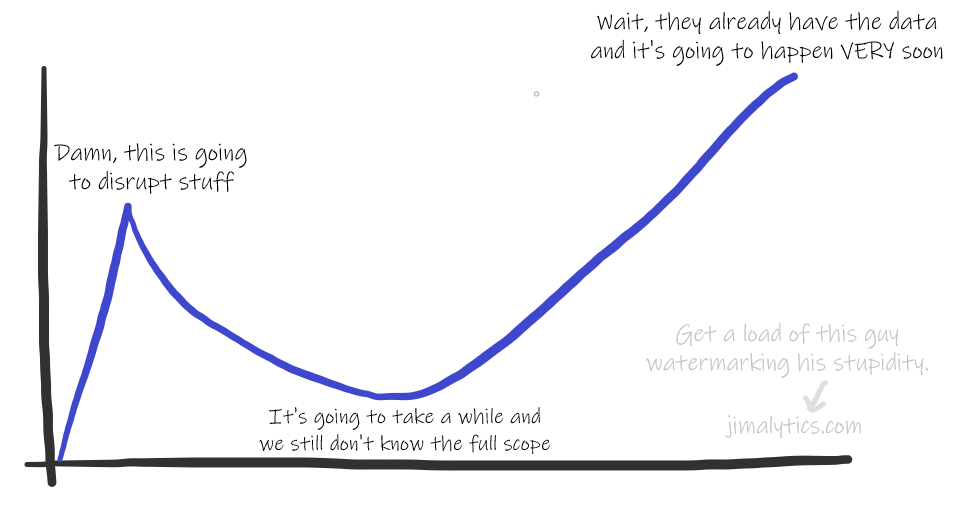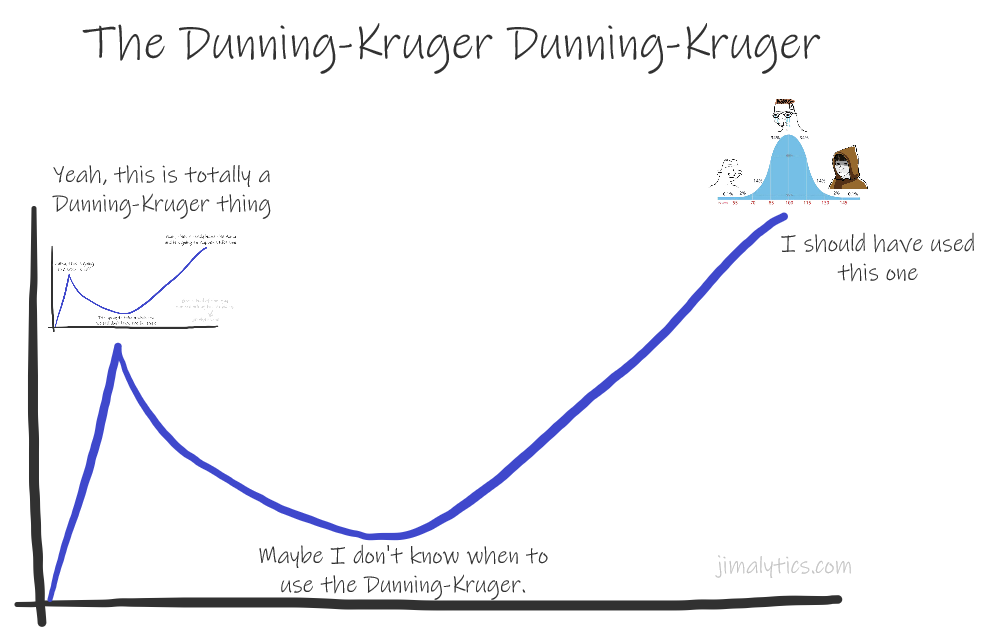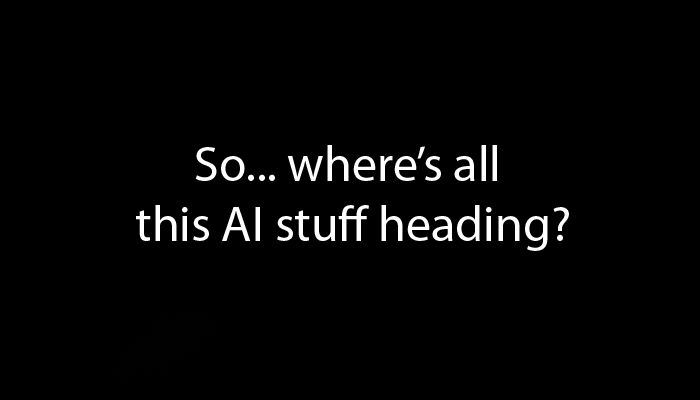This is a post about AI. Everything I’m about to write is incorrect. However, barring some overreaching legislation, I am confident it’s accurate. If that doesn’t pique your interest, I don’t blame you. My article on AEP Datasets is coming out soon enough. If you look at my last 4 or 5 thought pieces, you get a glimpse of what’s going on in my head. I’m trying to make sense of the world. Maybe it’s a coping mechanism, but generally understanding how things will look in 5 to 10 years helps make sense of today. Better yet, we’ll be able to anticipate and prepare as opposed to just letting change happen to us. This post isn’t so much about the analytics industry as it is how we need to think about what skills will be tangible vs. intangible in the near future.
Here’s where my head is at in the style of Dunning-Kruger:

And as a precaution, I created another Dunning-Kruger of this Dunning-Kruger:

The point is this – I think people underappreciate how profoundly their life will change in the VERY NEAR FUTURE as an outcome of applications of AI. It’s great at finding recipes and helping with code – and it’ll increment – but that will take quite a bit of time to mature. It’s not going to complete an analytics implementation anytime soon – maybe do some stuff with unstructured data. It can analyze data, but people REALLY struggle with asking good questions so that’s going to take a while, too. Its most immediate application will do something at a much larger scale – it will replace the need for memory (for the most part).
Table of Contents
AI You (AIU?)
In short, you’ll have a little AI version of you. Duh. Old news. But… I don’t think people realize how frighteningly-close we are to this and its implications. Like 1 teeny tiny layer away from it. Who’s immediately at risk? If your job exists to help people remember things, track projects, keep time, schedule stuff, read and synthesize, or prioritize – you will not be doing a lot of that in the very very near future.
Okay, let’s back up. We’ve heard this a hundred times. What’s the difference between what everyone else is saying and this article? None of them really talk about HOW this could be done. That’s a shitload of data. That’s a lot of integration, storage, processing, etc. It doesn’t seem real. Unfortunately for my lagging brain, it just clicked how EASY it is to achieve this… and how the enabling mechanisms have been around for over a decade.
That’s why I’m writing a post on this use case. It’s here and I don’t think many people understand that this could be less than a year away. Strike that. It already basically exists. Maybe that’s a bit of a sanitized version of a longer-term vision, but there it is. If this isn’t sinking in, I don’t blame you. This seems like a neat application you’ll use for business. Let’s adjust our focus a little bit:
- You won’t have to remember anything (how will this affect your brain?)
- Your voice can be stored and duplicated
- The voice of literally anyone you talk to for an extended period of time can be duplicated
- You’ll make a fraction of today’s decisions (focus on more important things?)
These are just a few points – and that first bullet point is something to latch onto. No need for a memory – it’s a little sensational; but there are entire careers built around compensating for this.
How is this done?
I said this was easy. Your smartphone listens to everything you say (yes, you can turn it off). Your browser knows everywhere you’ve been and can read everything on your screen. If I’m Google or Apple – I HAVE THIS DATA ALREADY. Everything you say and read already belongs to them. It’s stored somewhere – maybe not in the same way that’s 100% conducive to building a Large Language Model (LLM) – but the hardest part about training models like this is collecting the data. The data is there. Biggest step solved. That’s it.
Please someone respond and tell me how I’m wrong or way off in my interpretation of how browsers and voice recognition works. I understand it may not be at the scale of what’s necessary – but the most important building blocks are there. Oh, these companies have already mapped out your face through biometric screen unlock. I mean… not that they would use it. I don’t think any of us are important enough to be worried – but… just sayin’.
What’s next?
What makes you… YOU… will be stored. If you’re known for taking large amounts of data and making great decisions – you might have a business opportunity. Sell yourself with a Persona Subscription. Why not? I want to think and act like someone who is more successful. There’s someone who has opened their persona profile to a subscription service so you can make decisions just like someone you really admire. Maybe not a Tim Cook, but perhaps someone else – and you need that person’s help to make decisions just like them. For $250 per month, you can augment your personality to do just that!
So now we’re more effective, but there’s still interpersonal communication issues within the office. Let’s invest in a collective personality based on CEO Mary Smith with Personality AI’s enterprise singularity package! A little hyperbolic, but at some point this could be a thing.
I think we all know about the “raise the dead” use cases where you can extract (or buy) the personality of someone who has passed. That’s not a new idea or super relevant to the cohort reading this article, though.
How do I use this information?
Shit, I don’t know. I’m still trying to process this. Like I said, I’m wrong about the exact vehicle that will drive this fundamental shift in how we operate as humans. Precision is the enemy of accuracy, though. What becomes intangible if your thought patterns and decision-making are now tangible and (maybe inferior) commodities? I don’t think it will replace you completely; but what separates going to you vs. a trained model? I’ve asked myself this for the past year, but hadn’t couched it in this context – maybe it was a decade away… but it’s not. Maybe you have already thought about it like this and I’m just slow. I’m probably not going to be a best seller in the personality subscription store.
I don’t think AI can solve for intuition, though the law of averages might eventually prove that intuition is inferior to AI-driven decisioning. Analysts who are worried about being immediately automated out of a job shouldn’t worry. Nailing context is hard as hell – but it won’t be enough to just be organized and delegate. We’ll likely see a boom in the utility of unstructured data. Companies like Flexor are elevating this initiative. More importantly, the concept of “analysis paralysis” will eventually change – but that opens opportunities to ask better questions. In the very near future, I hope this outcome will filter out noise from day-to-day and allow us to focus more closely on creating business value.
What about after that?
That last section read like a “Final Thoughts”. Nope. The rabbit hole goes deeper. The logical next step – after your personality is captured – is to collect your biometric data… beyond face recognition. I’m talking blood samples. This is where we go off the rails. Unlike Elizabeth Holmes, I don’t have a definitive (read: incorrect) answer to a problem where the data collection requires something as invasive as taking a blood sample. However, this will lead to a revolution in proactive preventative care. The real kicker is eventually using tech as a neural manipulator to TREAT psychological conditions like (diagnosed) pain, depression, and anxiety – all without taking medicine.
So AI will know what you see, what you read, how you sound, what your basic biometrics are, and how your brain reacts to all of that stimulus – and then it will treat it.
Final Thoughts
So let’s outline where we are:
Personal AI Assistant
Broader Adoption Timeline: 1-2 years
Confidence of broad adoption: VERY high
Passively collect all of your voice and text data to coordinate your life. Eliminate the need to remember most things. Make faster (and hopefully better) high-context, high-level decisions.
Persona Sales
Creation Timeline: 2-5 years
Confidence it’ll be a thing: Meh.
Sell your persona to help people make better decisions. Use a single persona to achieve a company-specific singularity (not a literal singularity).
RELIABLE Biometric Monitoring
Creation Timeline: 5-10 years
Confidence it’ll be a thing: VERY high
Revolutionize preventative care.
Neural Manipulation
Creation Timeline: 10+ years
Confidence it’ll be a thing: High
Based on your biometric monitoring, stimulate your brain to do stuff like release serotonin to replace SSRIs. This could also replace a lot of conventional medicines – even treating pain. This is… a little sci-fi, especially if it’s something non-invasive.
This all feels dystopian. I guess it’s a paradigm shift. Maybe you’re reading this and thinking “No, we’re still miles away from this.” We’re not. We’re here. Maybe you’re saying you just won’t opt into it. Okay, fine. Maybe you’ll stand out – maybe be slower? More unique? Who knows? That’s not the point of this article. The point of this article is to talk about the most realistic, immediate, life-altering use case that requires the least context and fine-tuning for niche audiences. That’s what this is. You might have already known this – and to you I’m a guy who wrote an article about how floored I was to see a clown pop out a box with a wheel crank; but in the spirit of my last couple “thought piece” articles, I often feel like we know things without really understanding them.
It’s hard to move forward when you have no idea where the road will take you… or if it’s even a road. In my eyes – this is the road. We’ll be impacted in other ways long-term, but not in a way as profound in scale and immediate as this. I hope you enjoyed this and maybe helped you see the evolution of AI through a new lens.

1 thought on “Where’s all this AI stuff heading?”